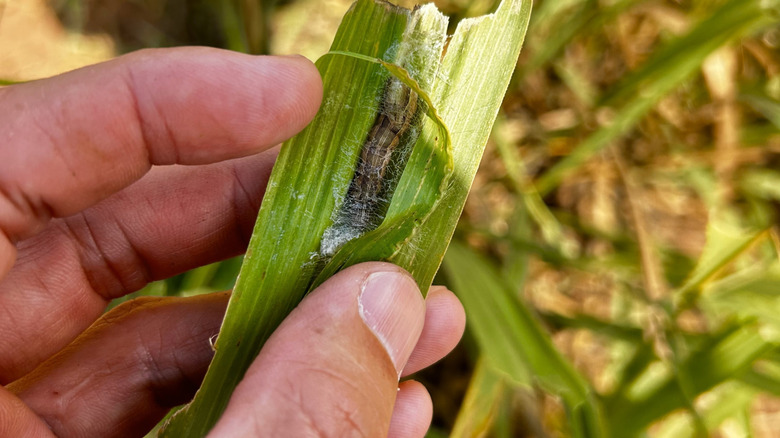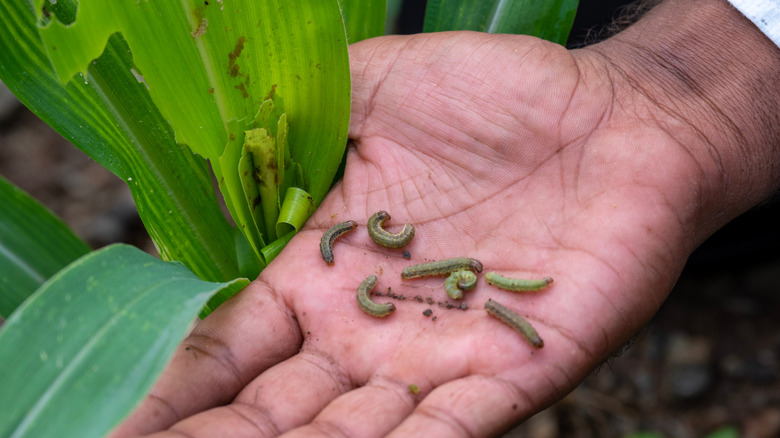Pesky Armyworms Are Attacking Kansas Yards & Gardens. Here's What You Can Do
The warm summer months are linked with increased pest activity across the country, and Kansas is no exception. This summer, though, Kansas residents are reportedly seeing an uptick in armyworms (Mythimna unipuncta) compared to 2024. Armyworm season officially begins in the late spring and runs through early fall in Kansas, with the highest numbers peaking during the summer months. The insect favors warm weather, and is not able to survive prolonged freezing temperatures. But as local KSNW News reports, the armyworms are evolving into an annual pest problem in the state thanks to consistently warmer winters. More armyworms in Kansas can mean increased problems for homeowners, as these caterpillars prefer eating and destroying healthy lawns in a short amount of time. The good news is you can take measures to protect your lawn, including using pest control and keeping it well-maintained and free of weeds.
Armyworms are identifiable by their green or gray bodies with long brown, yellow, and white stripes. They can also grow up to 2 inches in length before they turn into moths and no longer eat plants. These moth caterpillars are known to favor commercial crops, such as corn, rice, and wheat, but they can also cause problems in residential areas because of their preference for eating turf grass. In particular, armyworms have a liking for tall fescue grasses (Festuca arundinacea) in Kansas. If no grass is available, armyworms may also feed on broadleaf plants, too. Armyworms belong to the same family as cutworms, and they are native to both North and South America.
Another type of armyworm is also increasing in numbers in Kansas: the fall armyworm (Spodoptera frugiperda). Unlike traditional armyworms, this species goes south for the winter and then comes back to Kansas every July. The caterpillars then emerge in early fall.
Armyworms can quickly damage Kansas yards
Armyworms are undoubtedly a problem for Kansas farmers, but they're also becoming a nuisance for residential yards. Once these caterpillars start feasting on a healthy yard, they can cause some serious damage within 24 hours. Common signs include yellow or brown patches of grass. If you take a close look, you may be able to see the caterpillars hiding within your lawn.
Unfortunately, you may not notice armyworms in your yard at first because they tend to hide out in the ground and eat grasses from the bottom, working their way toward the top. They may go from one yard to the next in the area throughout the season. As Professor Jeff Whitworth, an entomology expert with Kansas State University, told The Wichita Eagle in July 2025, "They're going to continue probably for another month or two, or even three, depending upon the weather." The caterpillars are also nocturnal, which can explain why you might be witnessing dead areas of grass in your lawns with no clear cause during the day. Identifying armyworm damage and getting rid of them is critical in order to help save your yard.
How you can help minimize turf damage from armyworms in Kansas
Despite their increased numbers in 2025, Kansas residents still have some options to help minimize armyworm damage to their yards. First, you might consider using insecticides to control the caterpillars before they cause significant damage to your yard. It's best to work with a pest control expert in these situations, as concrete confirmation of the species is crucial for such products to work effectively. If you do decide to use insecticides yourself, be sure to read product labels carefully and make sure that the formula can treat yards for armyworms. You'll want to consider the downsides of using systemic pest control insecticides in your yard while weighing these against potential benefits. It's also worth noting that insecticides are not recommended for armyworm control in agricultural settings.
You might also consider taking steps now to help protect your lawn from armyworms next season. For homeowners, this often includes weed control. While armyworms don't eat weeds, controlling them can help prevent future outbreaks because adult moths tend to favor patches of dense weeds for laying eggs during the spring months. You'll also want to know the lawn mowing rule that's crucial for a healthy yard – not cutting more than a third of the grass at a time — and to regularly water and fertilize your grass as needed.


